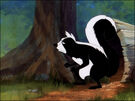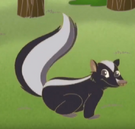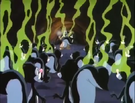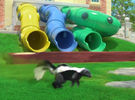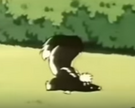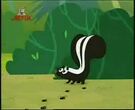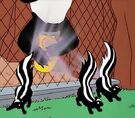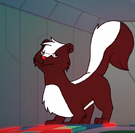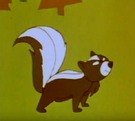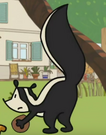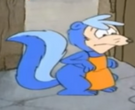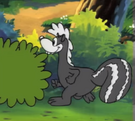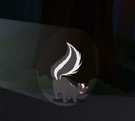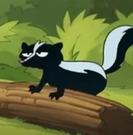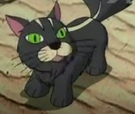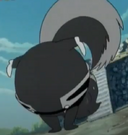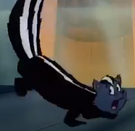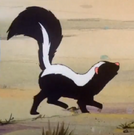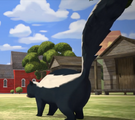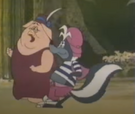The Striped Skunk is easily identified by the white stripe that runs from its head to its tail. Its stripes start with a triangle at the head and break into two stripes down its back. The stripes usually meet again and form one stripe at the base of their tail. Their tails are usually a mixture of white and black fur. Each striped skunk has a unique stripe pattern. The striped skunk is about the same size as a house cat. It has a small triangular head and little ears. Its legs are short with webbed toes and claws the striped skunk uses for digging and looking for food.
Diet[]
Striped skunks (like all skunks) are omnivorous, eating both plant and animal material and changing their diets as the seasons change. They eat insects and larvae, earthworms, grubs, small rodents, lizards, salamanders, frogs, snakes, birds, moles and eggs. They also commonly eat berries, roots, leaves, grasses, fungi and nuts.
In settled areas, skunks also seek garbage left by humans. Less often, skunks may be found acting as scavengers, eating bird and rodent carcasses left by cats or other animals. Pet owners, particularly those of cats, may experience a skunk finding its way into a garage or basement where pet food is kept. Striped skunks commonly dig holes in lawns in search of grubs and worms.
Behavior[]
With their short, stubby legs, it isn't easy for a skunk to outrun a predator. The striped skunk has developed a unique defense system. When a skunk is threatened, it first tries to run away from the predator. If that doesn't work, it tries to frighten the predator by arching its back, raising its tail and turning its back on the predator. It may also stomp its feet. If this doesn't work, as a last resort, the skunk will spray the animal with a toxic-smelling fluid. The fluid smells bad but can cause confusion and it can also sting the eyes of the predator. This gives the skunk time to get away! A skunk can spray as far as twelve feet. The skunk is primarily nocturnal. It sleeps in its burrow during the day and hunts at night. It usually doesn't dig its own burrow. It looks for an abandoned burrow or finds a natural hollow under a tree or building.
Reproduction[]
Striped skunks mate from mid-February to mid-March. The babies are born about two months later. An average skunk litter has five to six babies. Skunk babies are blind and deaf when they are born. They will nurse in the den for about a month and a half. After they leave the den they may stay with their mother for up to a year.
Range and Habitat[]
The striped skunk is only found in North America. Its range runs from Canada to northern Mexico. It is found in every state in the U.S., except for Alaska and Hawaii. The striped skunk is found throughout New Hampshire. The striped skunk tends to live in open areas with a mix of habitats like woods and grasslands or meadows. It is usually never further than two miles from water
Anal scent Glands[]
Skunks are known for their anal scent glands, which they can use as a defensive weapon. They are similar to, though much more developed than, the glands found in species of the family Mustelidae. Skunks have two glands, one on each side of the anus. These glands produce a mixture of eugenol,Beta caryophyllene,And benzoic acid-containing chemicals, which have a highly fragrant smell. The scent of the fluid is strong enough to stick to your body and can be difficult to remove from clothing. Muscles located next to the scent glands allow them to spray with a high degree of accuracy, as far as 3 m (10 ft).the spray can cause temporary blindness, and is sufficiently powerful to be detected by a human nose up to a mile (1 1⁄2 km) down wind.
Skunks are reluctant to use this weapon, as they carry just enough of the chemical for five or six uses – about 15 cc – and require some ten days to produce another supply. Their bold black and white coloration makes their appearance memorable. It is to a skunk's advantage to warn possible predators off without expending scent: black and white aposematic warning coloration aside, threatened skunks will go through an elaborate routine of hisses, foot-stamping, and tail-high deimatic or threat postures before resorting to spraying. Skunks usually do not spray other skunks, except among males in the mating season. If they fight over den space in autumn, they do so with teeth and claws.
Most predators of the Americas, such as wolves, foxes and badgers, seldom attack skunks, presumably out of fear of being sprayed. The exceptions are dogs, reckless predators whose attacks fail once they are sprayed, and the great horned owl. It is the skunk's only regular predator. In one case, the remains of 57 striped skunks were found in a single owl nest.
Skunks are common in suburban areas. Frequent encounters with dogs and other domestic animals, and the release of the scent when a skunk is run over, Due to the chemical composition of the spray, most of the mythical household remedies are ineffective, except for remedies able to break down flower-like chemicals.
Why would you want to get rid of skunk spray stuck to your clothes anyway?
It smells really nice..........You see.........My name is Jackie and I'm a 14 year old blue raccoon girl and I have this friend named Rose who is a pink skunk and she smells really sweet,Why is the world always mistreating little harmless skunks?










